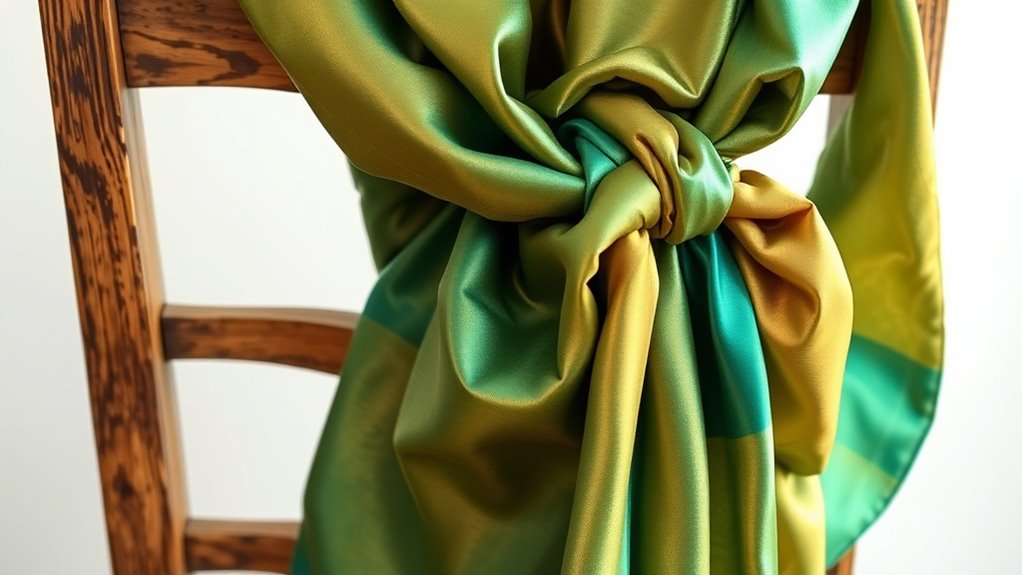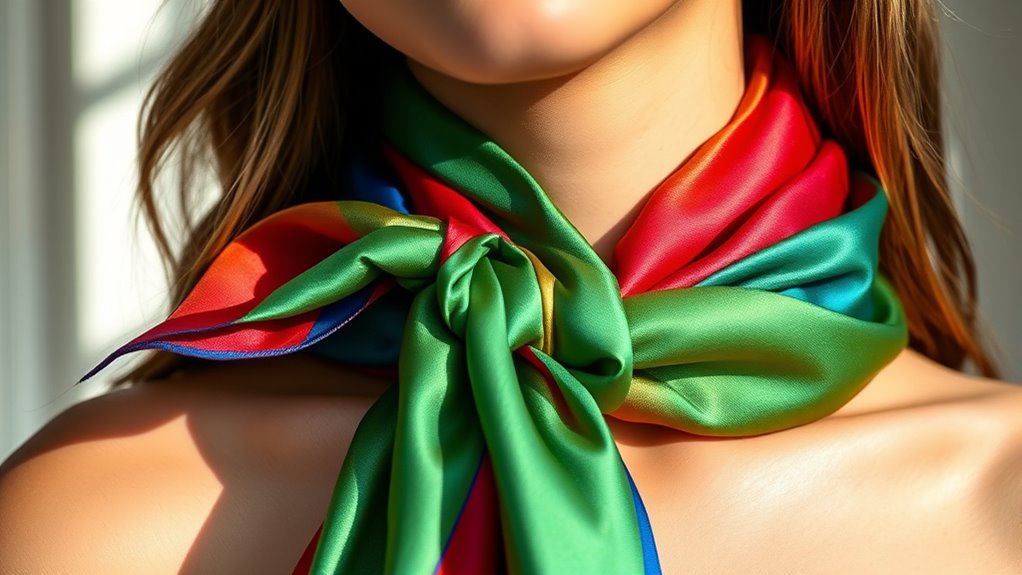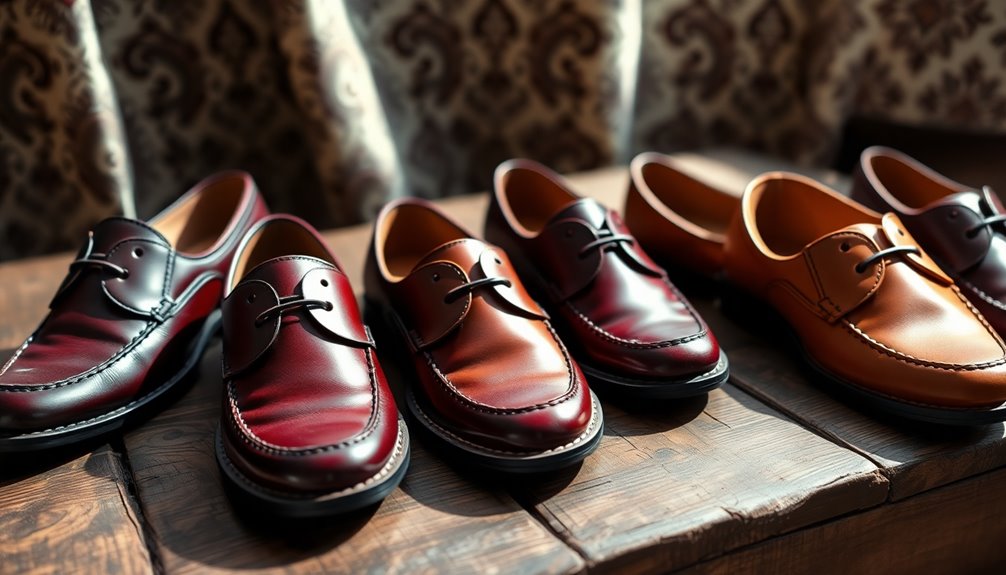To tie silk scarves in style, start with classic techniques like the loop knot, where you fold the scarf into a triangle and wrap it around your neck with a loose knot at the collarbone. For a refined look, try the French knot by wrapping and knotting the scarf at the front or side. Want more options? Styles like the ascot knot add vintage charm. Keep practicing these methods, and you’ll discover new ways to elevate your outfits.
Key Takeaways
- Use the classic loop knot for a versatile, elegant look suitable for both casual and formal outfits.
- Create a refined appearance with the French knot by wrapping the scarf into a narrow band and tying a small knot.
- Achieve a trendy, vintage style with the ascot knot by wrapping a long, thin scarf around the neck and tying loosely.
- Handle silk gently to prevent overstretching and practice different techniques to find your preferred style.
- Adjust knots for comfort and aesthetics, and experiment with variations to personalize your scarf styling.

Silk scarves are a timeless accessory that instantly elevates any outfit with their luxurious feel and vibrant colors. They’re versatile pieces that can be styled in countless ways, making them a must-have for anyone looking to add a touch of elegance to their look. When it comes to styling with silk, mastering the right knots for silk can make a significant difference in how your scarf complements your outfit. Whether you prefer a casual drape or a polished knot, understanding how to tie a silk scarf adds an element of sophistication and personality to your wardrobe.
Silk scarves elevate any look with their luxurious feel and vibrant colors.
One of the simplest yet most effective knots for silk is the classic loop knot. To achieve this, fold your silk scarf into a triangle, then roll or fold it into a long strip. Wrap the scarf around your neck, letting the ends hang in front. Bring the ends together and tie a loose knot, adjusting it to sit comfortably at your collarbone. This style works well with both casual and formal looks, offering a chic touch without much effort. It’s perfect for showcasing the vibrant patterns of your silk scarf while keeping it secure and stylish.
Another popular technique is the French knot, which adds a refined touch to your styling with silk. Fold the scarf into a narrow band, then wrap it around your neck once or twice, depending on the length. Cross the ends, then tie a small knot at the front or side. You can tuck the ends into the loop for a sleek, streamlined appearance or leave them hanging for a more relaxed vibe. This knot offers a sophisticated look that’s ideal for professional settings or upscale events. It highlights the luxurious texture of silk and keeps the scarf neatly in place.
For a more playful and trendy approach, try the ascot knot. Fold your silk scarf into a long, thin band, then wrap it around your neck with the ends crossing in front. Tie a loose knot, then slide the knot up or down to adjust the fit. Tuck the ends into your shirt collar or let them hang for a more relaxed look. This styling with silk adds a touch of vintage elegance that’s perfect for elevating casual outfits or adding flair to a blazer. It’s an easy way to experiment with different knots for silk and express your personal style.
In all cases, the key to mastering knots for silk is to handle the scarf gently, avoiding overstretching or pulling too tightly. Practice different tying techniques to discover what suits your style best. Additionally, understanding silk scarf knots and their variations can help you create more polished and versatile looks. With a little experimentation, you’ll find that tying silk scarves can become a quick, fun way to personalize your look, whether you’re dressing up for a special occasion or adding a subtle accent to everyday wear.
Frequently Asked Questions
Can Silk Scarves Be Worn as Headbands Safely?
Yes, you can wear silk scarves as headbands safely. Just make sure to handle the silk fabric carefully, avoiding excessive pulling or tight knots that could damage the delicate fibers. Store your scarves properly to maintain their quality and keep them wrinkle-free. Regularly clean and follow specific silk fabric care instructions to preserve their softness and shine. When worn gently, silk scarves make stylish and safe headbands for everyday use.
How Do I Prevent Silk Scarves From Slipping?
You can prevent silk scarves from slipping by increasing friction and adjusting fabric tension. Try applying a small amount of hairspray or a silk-friendly adhesive spray to the scarf’s underside to boost friction. Additionally, wrap the scarf snugly, but not too tight, to maintain fabric tension. Using a non-slip headband beneath or securing with hairpins also helps hold the scarf in place, ensuring it stays put all day.
Are There Eco-Friendly Methods to Tie Silk Scarves?
Yes, you can use eco-friendly methods to tie silk scarves. Opt for sustainable tying methods like knotting or twisting that don’t damage the fabric. Additionally, choose scarves dyed with eco-conscious dyes, which are better for the environment. This way, you enjoy stylish looks while supporting sustainable practices, reducing your ecological footprint, and ensuring your scarf stays beautiful without harmful chemicals or waste.
Can Silk Scarves Be Tied in Cold Weather?
Is a winter wonderland a reason to abandon style? Absolutely not. You can tie your silk scarf in cold weather, transforming it into a chic winter accessory that provides both elegance and warmth. Think of it as scarf insulation—a cozy layer against the chill. Use clever knots or wraps to keep the cold out, turning your silk into a functional, fashionable shield that elevates your winter wardrobe.
How Do Different Knot Styles Affect Silk Scarf Longevity?
Different knot styles impact silk scarf longevity by affecting knot tension and wear. Tighter knots can cause more stress on the delicate silk material, leading to faster fraying or tearing. Looser, gentle knots distribute tension evenly, preserving the scarf longer. You should choose knot styles that minimize strain, especially on fragile silk, and avoid pulling too tightly to make sure your scarf stays beautiful and intact over time.
Conclusion
Now that you’ve learned these tying techniques, your silk scarf becomes a vibrant ribbon of personality, weaving style into every movement. Imagine it as a gentle breeze dancing around your neck or a whispering stream that catches the sunlight, shimmering and alive. With a few simple twists and folds, you transform a plain piece of fabric into a canvas of self-expression. Embrace these tricks, and let your silk scarf be the brushstroke that paints your unique style across every day.










